|
|
(Your shopping cart is empty)
|
|
 |
|
|
Care and Planting Instructions
Most plants are shipped bare root and have been kept wet during shipping. They have been out of water for about 48 hours. Upon receiving them, it is important that you get them planted and back into water as quickly as possible.
Please Note:
Some plants, such as the "floating" Water Hyacinth (Eichhornia crassipes) and Water Lettuce (Pistia stratiotes) are considered prohibited, or noxious aquatic plants (nuisance weeds) in many states....usually in the southern, more "tropical" states, where freezing, winter temperatures do not exist to kill them, have been placed on federal or state-wide prohibited plant lists.
This list of "Prohibited" plants, at least where natural ponds are concerned, started out with tropical floating plants, where they can quickly and completely cover the surface of the water, disrupting and eventually killing, most of the life beneath them.
It is now apparent, as the interest of pond keeping continues to rise, that other states in our nation are finding (that other) nuisance plants exist in their own back yards and are beginning to place them on their own "Prohibited Plants List". The number of plants on these lists are growing (at both the state and federal levels), as is the number of states prohibiting them. This list now is beginning to include standard plants such as those found in the marginal/bog plant and submerged plant categories.
Before making your pond plant purchase, please take some time to look over our Prohibited Plants List, to see if the plants you want are on the list for your particular state.
By law, we cannot (and we will not) sell prohibited plants in those particular states that list the plants as "Prohibited" or "Noxious".
For all other plants in all other states:
Please, do the environment and the future of water gardening, as a whole, a favor and be responsible. Pond plants are a beautiful and useful addition to your pond or water garden. Keep these, and all other aquatic plants that you buy confined to your enclosed pond or watergarden, only. Please do not release them into wild or "natural" bodies of water.
Thank You....PPM!
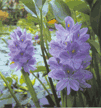
Floating Plants: come in various colors, shapes, sizes and textures. They help inhibit the growth of algae, by blocking the sun and using up nutrients. Floating plants float freely on the surface, absorbing nutrients with their dangling roots. (No need for potting.) Floaters can live in full to part sun and still or nearly still water. Floating plants make great choices for small ponds and tub gardens. Just toss in the water and forget about them. Treat as annuals in the north.
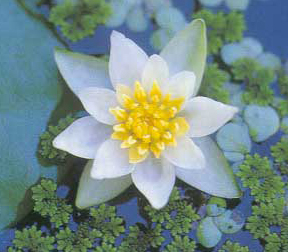
Hardy Water Lilies: Nymphaea likes still or nearly still water, and lots of sun. They generally need at least five to six hours of direct sunlight to bloom. Lasting from two to four days, the blooms start to open in the morning and close in the afternoon.
Begin planting hardy water lilies in the spring, after ice is gone from the pond's surface. Plant each lily in it’s own container, preferably one with no holes. Since hardy water lilies grow horizontally, the best planters are wider than they are tall.
For your growing medium, use heavy, ordinary garden soil (clay loam). Do not use peat based potting soils containing perlite or vermiculite. Pack the container approximately ¾ full. Mix in the proper amount of fertilizer, according to package directions. Place the rhizome near the side of the container at a slight angle, with the growing tip up and pointing towards the opposite end of the container. This will allow the plant to have room to grow. Add more soil to cover the roots and half of the rhizome. Pack in well. Fill to the top of the container with clean pea gravel (or larger), being very careful not to cover the growing tip. This keeps your fish from rooting through the mud and uprooting your plants. It also helps keep the mud from clouding the water!
Slowly lower the container into the water, so you don’t cloud the water. Set the container close to the surface (about 2” to 4” between growing tip and water surface) and gradually lower it as the water lily develops. Fertilize once every 3 to 4 weeks during peak blooming season, or use long lasting slow release aquatic tablets. Remove spent blooms and trim off yellowing or decaying leaves at the base.
Stop feeding when bloom production begins to slow. In the Autumn when cold weather sets in, neatly trim off all dead leaves and flower stems. Sink the pot and all to a deeper part of your pond (where the water won't freeze), to protect the roots from freezing.
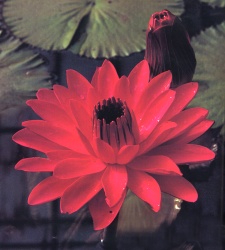
Tropical Water Lilies: cannot be reliably over-wintered north of USDA Zone 10, so treat them as annuals in northern climates. However, unlike hardy water lilies that tend to slow down their bloom production as cooler, autumn weather approaches, tropical water lilies will continue to bloom freely right up to the first frosts. Tropical water lilies like still, or nearly still water, and full sun.
The planting process for hardy water lilies and tropical water lilies are similar, except, tropical water lilies should only be planted outdoors when the air temperature and the water temperature is at least 70º F. In addition, the tubers should be planted in the center of the container, not to one side, as they grow up and out....not across the top of the container.
For your growing medium, use heavy, ordinary garden soil (clay loam). Do not use peat based potting soils containing perlite or vermiculite. Pack the container approximately ¾ full. Mix in the proper amount of fertilizer, according to package directions. Place one tuber in the center of each container, with the growing tip pointing up. Add more soil to cover the roots and half of the tuber. Do not cover the growing tip. Pack in well. Add an inch of clean pea gravel (or larger), being very careful not to cover the growing tip. This keeps your fish from rooting through the mud and uprooting your plants. It also helps keep the mud from clouding the water!
Slowly lower the container, so you don't cloud the water. Set the container close to the water's surface (about 2" to 4" between growing tip and water surface) and gradually lower it as the water lily develops. Fertilize once every 3 to 4 weeks during the peak blooming season or use long lasting slow-release aquatic tablets. Remove spent blooms and trim off yellowing or decaying leaves at base. Sit back and enjoy the show.
Continue feeding regularly, through autumn. When cold weather sets in, allow the lily to bloom right up to the first frost, then remove it from it's pot and throw it on your compost pile.
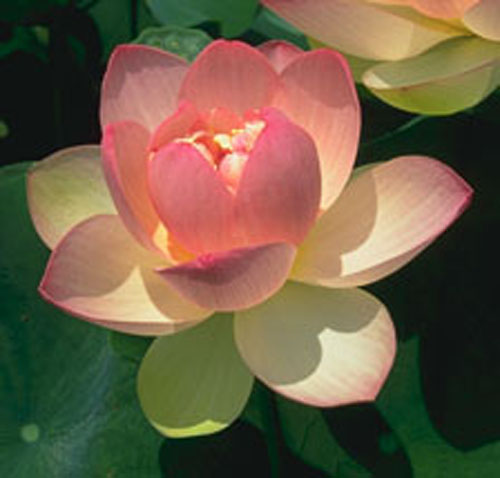
Lotus: Nelumbo prefer still water and at least 6 hours of direct sunlight. They need at least 6 to 8 weeks of sunny, 80º F weather and about 12 leaves (the first of which float on the water) to bloom. The huge blossoms can be single or fully double and can grow as wide as 12” across. They can take up to 3 days to fully open and remain open for 3 or 4 more days. The leaves are blue-green and can grow to 2 ft. in diameter. Follow hardy water lily planting directions. Use a large no-hole tub....one that is wider than it is tall.
For your growing medium, use heavy, ordinary garden soil (clay loam). Do not use peat based potting soils containing peat moss, perlite or vermiculite. Pack the container approximately 2" deep. Mix in the proper amount of fertilizer, according to package directions.
HANDLE THE BANANA-SHAPED TUBERS CAREFULLY. Even scratches in the tuber (which allow bacteria to enter), can cause a slow death to the lotus. However, growing the tuber in warm, well-aerated water, usually protects it from such infectious problems.
Place the tuber on top of the soil and against the side of the container, as the lotus plant/tuber will grow in a circular pattern. Add more soil to cover (half of) the long tuber. Add an inch of pea gravel (or larger), again being careful not to cover the growing tip. This keeps the fish from rooting through the mud....uprooting your plants and also helps keep the mud from clouding the water
Add water to the tub. The water level should be about 2” above growing tip. Gradually raise the water level in the tub (as the lotus develops), to at least 6” to 8” above the growing tip. Fertilize every 3 to 4 weeks during peak blooming season.
It's important to protect the roots from freezing. Sink the tub and all to the deepest part of your pond. Or, place the tub in an unheated (above freezing) garage or shed, until next season.
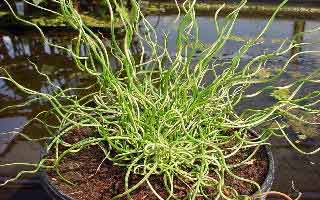
Hardy and Tropical Marginal/Bog Plants: marginal (or shoreline) plants are “non-water lily” aquatic plants. They're often planted along the “margins” or edges of water gardens. Some, like Water Snowflake (nymphoides), have floating leaves. Others, like Cattails (typha) and Pickeral Rush (pontederia cordata) have leaves or stems that emerge from the water.
Some people call all wet areas "bogs" and the plants for them "bog plants". Technically, the definition of a true bog is a wetland (or area), consisting of nutrient-poor, acidic, peat-like soil. Plants that grow there are true bog plants. Bog gardens are devoted to growing wet soil or swamp plants, whether hardy or tropical.
It is recommended that marginals be planted in containers submerged in water. This way the plant won’t grow out of control and can easily be moved anywhere in the water garden. Begin planting after the threat of frost is gone and the water warms significantly.
Plant as you would any other potted plant, except for the growing medium, use heavy, garden soil (clay loam). Do not use peat-based potting soil with vermiculite or perlite. Pack the soil around the plant and mix in the proper amount of fertilizer, according to package directions. Place the plant in the middle of the container. Add more soil to cover the roots and half of the plant as well. Add an inch of clean pea gravel (or larger), being careful not to cover the crown.
Slowly lower the container, so you don’t cloud the water. Set the container on the marginal shelf, at the proper height (use the recommended height for each specific plant). Use clay bricks under the containers, if necessary. Fertilize if needed, throughout the growing season. However, use fertilizer that is formulated specifically for aquatic plants (low nitrogen content), or you will create unnecessary algae problems. Yellowing, or broken leaves and stems, should be removed throughout the growing season.
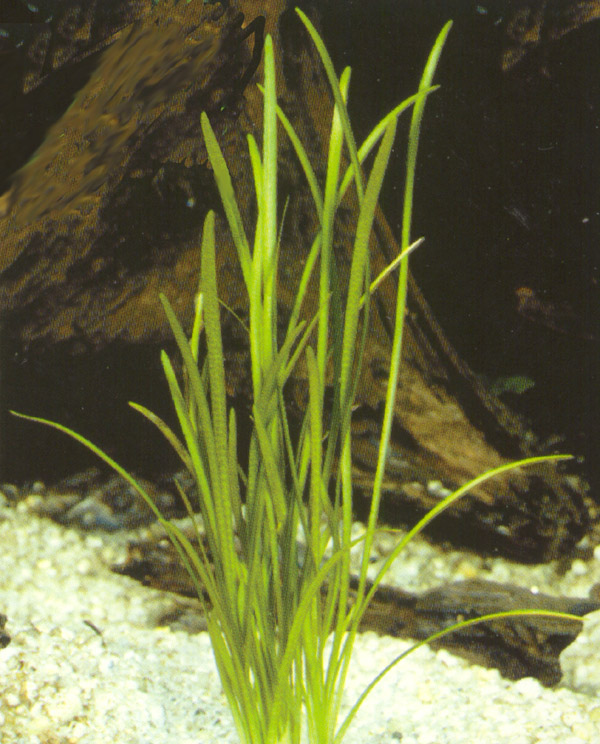
Submerged/Oxygenating/Aquarium Plants: These are soil rooted plants whose stems and foliage, with a few exceptions, are completely submerged. No water garden can maintain it’s health for long without them.
They produce oxygen and help filter the water as well. These plants provide the fish their main source of food, either directly or as a habitat for other organisms. They also provide a spawning area and protection for vulnerable fish frye. They compete for the same food source as algae, absorbing nutrients directly and helping to keep the water clean, clear and healthy.
Planting is simple – plant bunches, (1 bunch for every 1 to 2 sq. ft.) in pots filled with pea gravel (or larger)....you may use soil, but do not fertilize. Note: You may plant all of the required submerged plants in two or three planting containers. Set pots on the pond bottom.
It’s that easy! No soil is needed because oxygenators absorb nutrients through their foliage and not their roots. Their roots are used mainly to anchor them to the bottom of the pond.
|
|
|
|